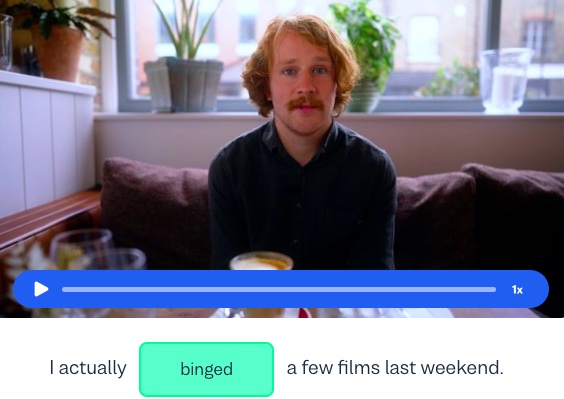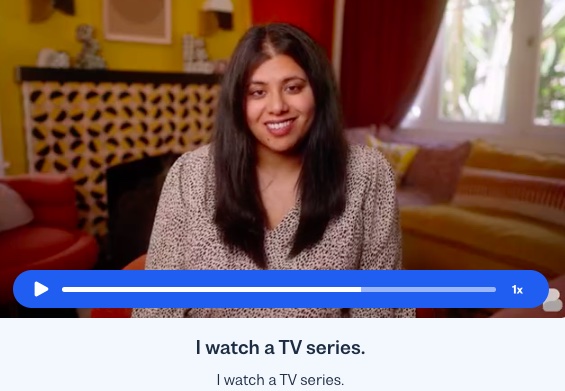How to Learn Languages with Netflix?
Watching movies and TV shows on Netflix is a great way to learn a language
I want to learn...
Let’s get straight to the point: Watching TV shows and movies is a proven way to learn a language (and it’s fun). To be more precise, mindlessly binging shows in a new language won’t help much. But if you’re intentional about how you use Netflix to learn a language, it can help you master a new language.
There is content on Netflix in over 60 languages. So unless you’re learning a super rare language, Netflix has something that can help you.
In this article, you’ll find out why it’s effective and what you can do to make sure you don’t waste your time.
Netflix and comprehensible input
One of the keys to learning a new language is comprehensible input and this is where Netflix really shines. Comprehensible input is language that is at, or slightly above, your current level. So it’s not too easy and it’s not too difficult. The more comprehensible input you can get, the more likely you are to learn a language.
Language teachers have known about the importance of comprehensible input in language acquisition for years. But getting access to the huge amounts needed was tough. Graded readers are a good source but they’re not cheap and you’d need a library full of them. Other than graded readers, teachers struggled to get enough resources. Until recently.
Netflix is a great source of authentic input that is almost impossible to match in a language classroom. It doesn’t cost a fortune. And there are thousands of hours of content at your fingertips — in tons of languages. Netflix has robust subtitles too. You can also pause, re-watch, or change the speed of the content.
Netflix is one way to solve the problem of not having enough input that language learners and teachers have struggled with for years.
The benefits of TV shows and movies for language learners
TV shows and movies have proven benefits for language learners. First of all, there’s something called the multimedia principle. It says that combining words and visuals leads to better learning and comprehension than words alone. Graded readers (and children’s books) often include images for this reason. Well, Netflix and video take this to the next level. The rich visuals you see when you’re watching your favorite show help you understand the words you hear.
This means watching TV shows and movies — like on Netflix — helps language learners improve their listening skills, learn new vocabulary, and gain cross-cultural awareness. Some research claims that learners can make significant progress in comprehension by watching as few as 10 episodes of a TV show. Because you can watch Netflix content on-demand, you can consume it whenever and wherever you want. And when you find a show you like, hitting that 10-episode mark is easy.
It already sounds conclusive that watching your favorite shows and movies can help you learn a language but there’s more. Research found that students using Netflix to learn had more motivation to study English. More motivation means more enjoyment and better learning outcomes.
Noticing the gap
And finally watching videos is a good way for language learners to notice gaps in their ability. Here’s how that works:
Let’s say you're learning Spanish at a language school in your home country. So far you’ve only ever learned in the classroom. Your whole experience with Spanish is classroom based. You’re doing well in class and making good progress so you decide it’s time to try watching a Spanish-language movie.
You remember hearing about a Mexican movie that did well at the Oscars: Roma (also included in our top 10 list of Spanish movies to watch this year). You sit down, get some snacks, and start the movie. You hear authentic — not classroom-based — Spanish for the first time. Informal, everyday Spanish. And it’s completely different from what you’ve heard in class. This gives you the opportunity to compare your knowledge with real Spanish. You can see the difference between written and spoken Spanish for example. You get a deeper understanding of the language that you couldn't get in the classroom.
This kind of interaction with a language is hard to come by if you don’t live overseas. If you do, every interaction you have gives you the chance to spot gaps in your knowledge. But for people who are learning a new language at home, Netflix can fill in and help out.
How to make the most of Netflix as a language-learning tool
1. Use subtitles — but not in your native language
Key to incidental vocabulary learning through Netflix, movies, and TV shows are subtitles. It can be tempting to watch a foreign movie with your native language subtitles. This makes sense. When you watch a foreign movie for entertainment, that’s what you do.
But that’s not the best way to learn a language. Research shows that audio and subtitles in your second language are more effective. If the subtitles are in your native language, you end up focusing on them. And not the language you’re learning. So don’t mix and match your native and new language like that.
Resist the urge to take the easy route. Set the subtitles and the audio to the same language. You won’t understand everything but that’s ok. You’ll understand enough to learn.
2. Re-watching is better than binging
To learn a new word or grammar function, you need to encounter it in the input between six and twenty times. This means that watching one movie at a just one time won’t cut it. You probably won’t hear the same words and grammar enough by watching a movie once. You could re-watch the same movie multiple times to help out with this. You might then get enough repetition to learn the new word or grammar but that’s going to take ages.
But luckily, you can stream more than movies on Netflix. For language learning, TV shows are where it’s at. Online TV shows are ideal for language learning because they’re short, easy to rewatch, and accessible anywhere at any time.
This accessibility of Netflix means it’s super easy to re-watch the same content. I know, I know — everyone wants to binge-watch the series to see what happens at the end. And if we’re only thinking about entertainment, that's the most fun. But for language learning, repetition is key.
So watch the same content over and over. Pause to think. Rewind to watch again. Take advantage of Netflix’s playback features to get enough repetition in. And if you come across an episode that was difficult to understand, watch it again. And again. And again.
Supplement learning through Netflix with Busuu
The incidental learning you get from Netflix content is great. Combine that with intentional learning through Busuu and you get the best of both worlds. Communicate with native speakers, be a part of real-life conversations, and complete online courses all from your mobile device.
Recommended articles
- Yes in Japanese: Learn the right words to say yes
- Linguistic Immersion: Tips to Immerse in a Language
- 7 Tips on How to Speak French Fluently
- 4 Ways Emojis Can Help in Learning a New Language
- Sicilian vs Italian Language: A Comparison
- Personal Pronouns: Grammar Explained in Detail
- How Polyglots Learn Languages: Apply Their Methods
- French Alphabet: Letters and Pronunciation
- 8 Different American Accents & Pronunciation Tips
- French Months of the Year: Tips to Memorise Them
- English Grammar: How to Study and Learn It Well
- How to Order Food in Japanese: A Step-by-Step Guide
New articles
- Japanese Verb Conjugation: All the Basics You Need
- Rules and Examples of English Reported Speech
- English for Beginners: How to Tackle the First Stage
- Italian Indefinite Articles: How to Use Them?
- The 5 French Relative Pronouns: Usage & Examples
- Reflexive Verbs in Spanish: How to Use Them?
- 10 English expressions and their meanings
- Spanish Comparatives: When & Where to Use Them?
- Best Way to Learn Japanese: 5 Top Tips
- The Busuu methodology to teach and learn a language
- French Prepositions: How to Use Them (Full List)
- Learning Language Through Music: 10 Benefits

